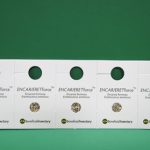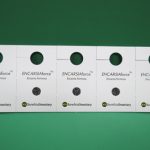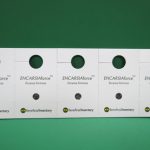Description

Encarsia formosa, specifically the greenhouse whitefly parasite, is a well-tested solution for the prevention and low-infestation management of greenhouse whiteflies. These 0.7mm mini-wasps are best used for preventing the establishment of the greenhouse whitefly (Trialeurodes vaporariorum). They can also tackle minor to medium infestations. And, if established, they can adequately protect a crop throughout the season. In addition to the greenhouse whitefly, Encarsia formosa can parasitize a few other whitefly species, the sweet potato whitefly (Bemisia tabaci), for example. Acceptable prevention and control of other whitefly species, however, is effectively unobtainable with Encarsia formosa and we do not recommend their use for this purpose. (For those species, use Eretmocerus eremicus)
Encarsia formosa are supplied as pupae protected in the greenhouse whitefly scales (pupae) which they had used as a host, and actually still are. These parasitized scales are adhered to a small card which can be hung in the plants.
Life-style
Encarsia formosa, as parasitoids, work by laying eggs in the 2nd through 4th immature whitefly stages. The wasps’ larvae which hatch from the eggs, slowly weaken and kill the developing whiteflies from within (endoparasitism) causing noticeable changes upon pupation (see Scouting). And each female wasp (they’re all females by the way) can do this up to 200 immature whiteflies! The life-span of these parasitoids is roughly 3 weeks in their immature stages, then up to a month as adults. The conditions for optimum performance will be between 68-77°F with a relative humidity of 70% or less. But these are optimum conditions, and not necessarily a prerequisite of successful implementation. Please note, however, cooler temperatures will hamper reproduction and development a certain degree. For example: these wasps won’t fly when temperatures are below 62°F (see Drawbacks).
Benefits
They are very effective preventative agents capable of small-scale control as well. Consequentially, between their low price and resulting prevention, a lot of money can be readily saved, plus a lot of headaches and plant damage avoided. Moreover, they are really easy to scout (see Scouting). And they’re a great part of an IPM program, with quite a few pesticide tolerances. There is a lot of information out there about these parasitoids. Combined, growers probably have a thousand years or more of experience with these mini-wasps.
Drawbacks
They can’t fly below 62°F, but we’re not sure what kind of drawback this really is. As long as daytime temperatures are high enough, you’ll be okay. These wasps are also temperamental about light levels (see Advisories). Honeydew levels, if high enough, can interfere with their performance. A couple of different things can play a role (again, see Advisories).
Scouting
The scales or pupae of the greenhouse whitefly turn jet black when parasitized. This is a great indicator. The scales of the Bemisia tabaci turn tan-brown when, on occasion, they, too, become a host to Encarsia formosa. Yellow sticky traps might not be able to be used at times (see Advisories).
Advisories
Yellow sticky traps should be removed prior to releasing these mini-wasps. To monitor for thrips, use blue traps. If yellow traps must be used for fungus gnats, etc., hang them for only two days per week. To reduce adult whitefly levels, fast, instead of placing about a million sticky traps up, Suck ‘em up!
Ants, if present, should be controlled. They will defend whiteflies from predators and parasites to protect their honeydew food. Use barrier products or boric acid products to control the ants. If your planting doesn’t have any ants, check to be sure that the honeydew isn’t too heavy. This may prove to be a hindrance to the parasitoids’ performance; they may spend too much time cleaning themselves. Washing the plants with soap and water — at the highest possible pressure — may help reduce the amount of honeydew. In order for Encarsia to be effective, the release site must be brightly lit, with a minimum of 650 footcandles. Photoperiod or day-length doesn’t seem to be of importance, just intensity. By the way, the required light-levels are achieved in normal greenhouse conditions — on a sunny day.
Some crops, due to their excessive whitefly susceptibility, may require special IPM attention, higher release rates and/or more frequently scheduled releases (closer intervals). Greenhouse tomato production is one example. Another example of a highly susceptible plant would be the eggplant, but it might be used to your favor as a place to harbor and maintain your good guys. A banker plant.
Usages
Most greenhouse crops and brightly lit interior situations. We’ve seen the successful preventive and light curative implementation of these species in nearly every qualifying situation. We do not recommend the outdoor use of Encarsia.
Release rates
Recommended introduction rates will vary depending on the crop species, as well as on the time of year and population of the pest, but a general recommendation is to release at the rate of 0.1 Encarsia per square feet weekly until adult whitefly are seen, and then increase the rate to 0.2 Encarsia per square feet each week. Monitor the lower leaves for the presence of black scales, and when 90% of those present are black, reduce applications. It is important not to remove the black scales before they have emerged, as much of the control relies upon the Encarsia that are breeding within the crop.
Produced in the USA by Beneficial Insectary!
Purchase
-

ENCAR/ERETforce™ – whitefly parasite mix 100 per card (5,000/ 10,000/ 15,000)
$107.95 – $159.95 Select options This product has multiple variants. The options may be chosen on the product page -

ENCARSIAforce™ – whitefly parasite 100 per card (10,000/ 15,000)
$94.95 – $139.95 Select options This product has multiple variants. The options may be chosen on the product page -

ENCARSIAforce™ – whitefly parasite 50 per card (3,000/ 7,500)
$48.95 – $71.95 Select options This product has multiple variants. The options may be chosen on the product page
